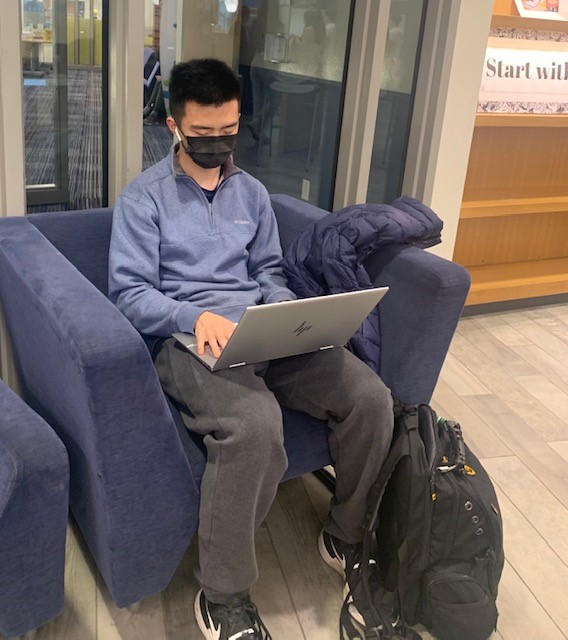Major WiFi upgrades due amid unrest over WiFi inadequacy
Students are still unsatisfied with the WiFi, despite renovations
Lin
Senior Zijun Deng finishes homework on his laptop. Students require WiFi to use different devices, including iPads, laptops, and phones.
Improvements to New Trier’s student WiFi system over winter break are expected to bring increases of up to nine times in speed.
This comes as many students are frustrated about the quality of the WiFi service at New Trier.
“It’s spotty and unreliable,” says sophomore Devan Weinstein. “It’s also inconvenient with there being two networks when sometimes only one works.”
Chief Technology Officer Michael Marassa explains that these issues are a product of new devices running on old hardware.
“Many of our servers were installed in the early two-thousands, which is a problem given that we’re living in 2022.”
The WiFi network consists of a series of network routers and switches, both of which direct the flow of digital traffic as students access the internet. They can also connect to wireless access points which deliver signal to individual classrooms, increasing the range and strength of the network.
A little larger than an iPad, each wireless access point has a cable 300 feet long that must be connected to a network switch. It took arduous planning to figure out where to house these switches in order to provide the signal needed to cover the entire school.
Marassa says these access points are also being installed on the outside of the building and in athletic facilities to support New Trier athletes.
“We have over 600 new wireless access points ready to be installed around the school over winter break,” pointed out Marassa.
These additions should boost WiFi speeds from one GB to up to eight or nine GB by the end of winter break.
Other equipment had been updated over the course of the last two years.
Network routers at the Winnetka campus were upgraded in the summer of 2020. Classrooms in the northern part of the building and in the tower section had been running on wiring from the 1990s, network switches from 2008, and wireless access points installed in 2010. This hardware has struggled to keep up with the rapid advancements in personal technology and the increase of technology use in school.
However, Weinstein questions whether much else has changed since the initial work began two years ago. She notes that coverage is spontaneous and changes daily.
“It still cuts out randomly and there’s still the issue of having two networks where sometimes only one works.”
Sophomore Casey O’Keefe agrees. “Since I left the Northfield campus, it’s gotten slower and less reliable.”
Marassa joined the technology department the same year that New Trier went remote due to the outbreak of COVID-19. He quickly noticed the unreliability of the student WiFi at both the Northfield and Winnetka campuses.
Most updates to the student network didn’t get started until after students and teachers got settled into online learning.
Marassa also noted the department ran into some delays as they continued to update the system.
“Shipping time for technology is pretty high right now,” he said, “We had to purchase the hardware well ahead of time in order to complete the work.”
That work continued in the spring of 2022, when the outdated cabling at the Winnetka campus was replaced, followed by upgrades to 130 network switches. In doing so, the connectivity between the network routers and switches was also increased from 20 GB to 50 GB.
Meanwhile, the technology department has been testing the new network. Marassa says they have been able to use it seamlessly without having to manually switch networks on their devices, often a major sticking point with students.
Marassa points out it’s important that the WiFi coverage stays consistent across both the older and newer areas of the school. The department plans to use the help of consultants to analyze the strength of the network across the building. They also have extra access points which Marassa says can be used to fill in any gaps in the school’s network.
This project comes with a considerable price tag. The renovations total around $2.6 million, an increase from the $1.5 million budget proposed last year.
However this is worth it, Marassa argues, for a school with a large student body and such high standards of education.
“As our reliance on technology increases,” concludes O’Keefe, “so does the importance of internet connection in school. New Trier needs to provide that.”








































